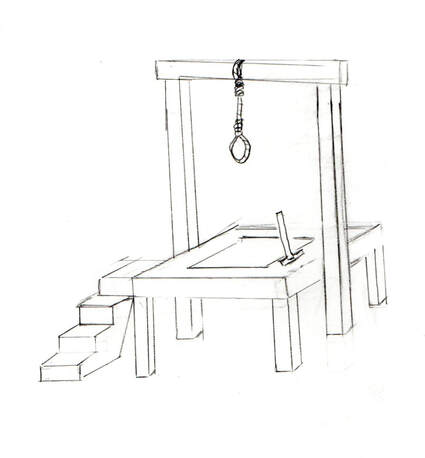Early Court History - "The Hanging of Cornelius Hammon"
Article from The Benton County Democrat (1950), The Century of Progess Edition - Now the NWA Democrat Gazette
Article from The Benton County Democrat (1950), The Century of Progess Edition - Now the NWA Democrat Gazette
Some of the proceedings of the early criminal courts should be preserved for future generations, one especially, the trial of Cornelius Hammon. He, with Girsham P. Hoytt, was indicted in October, 1875, for the murder of Columbus Hancock, living in White Hollow, near White River, on August 4, 1875. On being arraigned they plead not guilty and Hoytt asked for a change of venue and was later tried in Washington County, and found not guilty.
The trial of Hammon was held here. Col. Sam Peel was the prosecuting attorney at the time and John M. Peel represented Hammon. During the argument at the trial, John M. Peel, stated that from the kind of life, and clothing of the deceased, Columbus Hancock, the jury could judge that he would not have been murdered for money. Col. Sam Peel, looking over the court room, saw Uncle Hugh Middleton in the crowd and asked him to stand up. He stated that the clothing worn by Hancock was no worse than worn by Mr. Middleton and that everyone knew that Mr. Middleton was one of the wealthiest men in the county.
The jury, with John W. Floyd as foreman, returned the verdict: "We, the jury, find the defendant, Cornelius Hammon, guilty of murder in the first degree, as charged in the second count of the indictment." Hammon was sentenced by the court to be hanged on the 14th day of January, 1876, between the hours of 10 in the morning and 2 o'clock in the afternoon at some point selected by the sheriff, J. H. McClinton, within two miles of said court house.
The scaffold was erected just west of the Razor Back Inn on the south side of the road, on one of the knolls. At the time of the hanging there was said to be the largest crowd that had ever gathered in the county up to that time. Hammon was taken from the court house in a wagon, riding astride his coffin. One of the old timers who witnessed this related it to me several years ago, Sam B. Maxwell. He said that people came on foot, horse back and in wagons and that in passing Hammon, he admonished them "not to be in any hurry as nothing was going to happen until he got there."
The scaffold stood there for more than 50 years as a grim reminder, and has been seen by many of the present generation as it rotted to the ground.
The trial of Hammon was held here. Col. Sam Peel was the prosecuting attorney at the time and John M. Peel represented Hammon. During the argument at the trial, John M. Peel, stated that from the kind of life, and clothing of the deceased, Columbus Hancock, the jury could judge that he would not have been murdered for money. Col. Sam Peel, looking over the court room, saw Uncle Hugh Middleton in the crowd and asked him to stand up. He stated that the clothing worn by Hancock was no worse than worn by Mr. Middleton and that everyone knew that Mr. Middleton was one of the wealthiest men in the county.
The jury, with John W. Floyd as foreman, returned the verdict: "We, the jury, find the defendant, Cornelius Hammon, guilty of murder in the first degree, as charged in the second count of the indictment." Hammon was sentenced by the court to be hanged on the 14th day of January, 1876, between the hours of 10 in the morning and 2 o'clock in the afternoon at some point selected by the sheriff, J. H. McClinton, within two miles of said court house.
The scaffold was erected just west of the Razor Back Inn on the south side of the road, on one of the knolls. At the time of the hanging there was said to be the largest crowd that had ever gathered in the county up to that time. Hammon was taken from the court house in a wagon, riding astride his coffin. One of the old timers who witnessed this related it to me several years ago, Sam B. Maxwell. He said that people came on foot, horse back and in wagons and that in passing Hammon, he admonished them "not to be in any hurry as nothing was going to happen until he got there."
The scaffold stood there for more than 50 years as a grim reminder, and has been seen by many of the present generation as it rotted to the ground.

